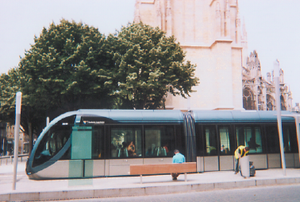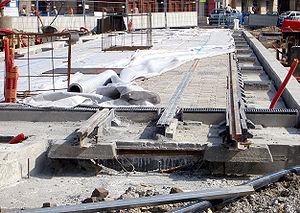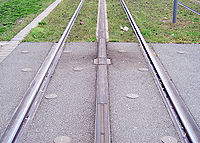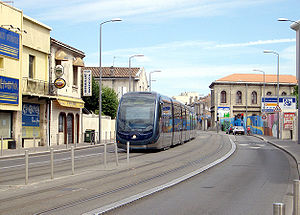
Ground-level power supply
Encyclopedia




Third rail
A third rail is a method of providing electric power to a railway train, through a semi-continuous rigid conductor placed alongside or between the rails of a railway track. It is used typically in a mass transit or rapid transit system, which has alignments in its own corridors, fully or almost...
electrical pick-up for street tram
Tram
A tram is a passenger rail vehicle which runs on tracks along public urban streets and also sometimes on separate rights of way. It may also run between cities and/or towns , and/or partially grade separated even in the cities...
s. It was invented for the Bordeaux tramway, which was constructed from 2000 and opened in 2003. Until 2011, this is the only place it is used but there were and are proposals to install it elsewhere. Reims has adopted this technology for its new Reims Tramway, which was opened in 2011, as has Angers
Angers tramway
The Angers tramway is a tramway in the French city of Angers. Opened on 25 June 2011, Line A is operated by Keolis and replaced some bus lines, with the buses redeployed throughout the rest of the metropolitan area. Alstom's APS ground-level power supply has been used on two parts of the line...
.
Technology
Ground-level power supply is used, primarily for aesthetic reasons, as an alternative to overhead linesOverhead lines
Overhead lines or overhead wires are used to transmit electrical energy to trams, trolleybuses or trains at a distance from the energy supply point...
. It is different from the conduit current collection
Conduit current collection
Conduit current collection is a system of electric current collection used by electric trams, where the power supply is carried in a channel under the roadway, rather than located overhead.-Description:...
system which was one of the first ways of supplying power to a tram system by burying a third and fourth rail in an underground conduit (‘vault’) between the running rails. Conduit current collection was used in historic tram systems in Washington
Washington streetcars
For just under 100 years, between 1862 and 1962, streetcars in Washington, D.C. transported people across the city and region.The first streetcars in Washington D.C...
, Manhattan, Paris, Berlin, Marseilles, Vienna, Budapest and London
Trams in London
There have been two separate generations of trams in London, from 1860 to 1952 and from 2000. Between 1952 and 2000, no trams ran at all in London.- Horse trams :...
. It fell into disuse because overhead wires proved much less expensive and troublesome for street railways and because in Manhattan, Paris, Washington and West Berlin all trams were replaced by buses for reasons unrelated to the power supply issue. In Prague on the Charles’ Bridge (Karlův most) was used a system, invented by František Křižík, which was similar to today’s APS.
Unlike the track-side third rail
Third rail
A third rail is a method of providing electric power to a railway train, through a semi-continuous rigid conductor placed alongside or between the rails of a railway track. It is used typically in a mass transit or rapid transit system, which has alignments in its own corridors, fully or almost...
used by most metro
Rapid transit
A rapid transit, underground, subway, elevated railway, metro or metropolitan railway system is an electric passenger railway in an urban area with a high capacity and frequency, and grade separation from other traffic. Rapid transit systems are typically located either in underground tunnels or on...
trains and some main-line railways, APS does not pose a danger to people or animals and so can be used in pedestrian areas and city streets.
APS uses a third rail placed between the running rails, divided electrically into eight-metre segments with three-metre neutral sections between. Each tram has two power collection skates, next to which are antennae that send radio signals to energise the power rail segments as the tram passes over them. At any one time, no more than two consecutive segments under the tram should actually be live.
Use in Bordeaux
Modern ground-level current collection was pioneered by the recent BordeauxTramway de Bordeaux
The Bordeaux tramway network consists of three lines serving the city of Bordeaux in southwestern France. The first line was opened on 21 December 2003; further extensions have increased the route length to . The system is notable for using a ground-level power supply of the Alimentation par Sol...
tramway in France
France
The French Republic , The French Republic , The French Republic , (commonly known as France , is a unitary semi-presidential republic in Western Europe with several overseas territories and islands located on other continents and in the Indian, Pacific, and Atlantic oceans. Metropolitan France...
. The public had assumed that the new system would use a traditional conduit system, like that of the Bordeaux trams which ran prior to 1958 and objected when they learned that it was not considered safe and that overhead wires were to be used instead. Facing complaints both from the public and the French Ministry of Culture, planners developed APS as a modern way of replicating the conduit system.
APS was developed by Innorail, a subsidiary of Spie Enertrans but was sold to Alstom
Alstom
Alstom is a large multinational conglomerate which holds interests in the power generation and transport markets. According to the company website, in the years 2010-2011 Alstom had annual sales of over €20.9 billion, and employed more than 85,000 people in 70 countries. Alstom's headquarters are...
when Spie was acquired by Amec.
There are 12 km of APS tramway in the three-line network of 43.3 km as of 2008. Sources suggest that APS adds about €
Euro
The euro is the official currency of the eurozone: 17 of the 27 member states of the European Union. It is also the currency used by the Institutions of the European Union. The eurozone consists of Austria, Belgium, Cyprus, Estonia, Finland, France, Germany, Greece, Ireland, Italy, Luxembourg,...
100,000 to the cost of the trams, whilst the infrastructure is about 300% more expensive than overhead wires. Bordeaux Citadis
Citadis
The Citadis is a low-floor tram built by Alstom in La Rochelle, France, and Barcelona, Spain. 1,140 Citadis are currently in use in 28 cities, among others: Bordeaux, Grenoble, Lyon, Montpellier, Orléans, the Paris area, and Barcelona, Dublin, Gdańsk, Katowice, Adelaide, Melbourne, Jerusalem and...
tram
Tram
A tram is a passenger rail vehicle which runs on tracks along public urban streets and also sometimes on separate rights of way. It may also run between cities and/or towns , and/or partially grade separated even in the cities...
s use pantograph
Pantograph (rail)
A pantograph for rail lines is a hinged electric-rod device that collects electric current from overhead lines for electric trains or trams. The pantograph typically connects to a one-wire line, with the track acting as the ground wire...
s and electric overhead lines
Overhead lines
Overhead lines or overhead wires are used to transmit electrical energy to trams, trolleybuses or trains at a distance from the energy supply point...
in outlying areas.
Before use in Bordeaux, APS was tested and proved viable on a short section of reserved-track
Reserved track
In tram transport terminology reserved track is track on ground exclusively for trams. Unlike track on streets and roads, reserved track does not need to take into account the transit of other wheeled vehicles, pedestrians, bicyclists or horses...
tramway in the French city of Marseilles. Nevertheless, Bordeaux has experienced problems, with APS being so temperamental that, at one stage, the Mayor issued an ultimatum that if reliability could not be guaranteed, it would have to be replaced with overhead wires. Although things have improved, in October 2005, it was announced that 1 km of APS tramway is to be converted to overhead wires.
Problems have included water-logging, when the water does not drain quickly enough after heavy rain.
In other cities
In July 2006, it was announced that two new French tram systems would be using APS over part of their networks. These are Tramway d'AngersAngers tramway
The Angers tramway is a tramway in the French city of Angers. Opened on 25 June 2011, Line A is operated by Keolis and replaced some bus lines, with the buses redeployed throughout the rest of the metropolitan area. Alstom's APS ground-level power supply has been used on two parts of the line...
and Tramway de Reims
Tramway de Reims
Reims tramway is a transportation system in the French city of Reims opened in April 2011. It travels through the town from North to South, along a 11km long track. The project is set to cost €342,780,000 - i.e...
, with both systems opening in 2011. A couple of months later, another French city was added to the list, this being Orléans
Orléans
-Prehistory and Roman:Cenabum was a Gallic stronghold, one of the principal towns of the Carnutes tribe where the Druids held their annual assembly. It was conquered and destroyed by Julius Caesar in 52 BC, then rebuilt under the Roman Empire...
, which will use APS on a section of its second tram line. The planned Al Sufouh Tramway
Al Sufouh Tramway
Al Sufouh Tramway is a tramway being built in Al Sufouh, Dubai. It will run along Al Sufouh Road from Dubai Marina to the Burj Al Arab and the Mall of the Emirates. It is expected to interchange with three stations of Dubai Metro's Red Line.The trains will comprise of First Class , and a carriage...
in Dubai will use APS..
Other cities to propose the use of APS include:
- NiceTramway de NiceThis article is about the new tramway of Nice, for the old network, see Tramway de Nice et du LittoralThe Nice tramway is a tram system of 8.7-km rail, currently composed of one line, and operated by the Société nouvelle des transports de l'agglomération niçoise, under the trade name of Lignes...
, France (abandoned in favour of nickel metal hydride batteriesNickel metal hydride batteryA nickel–metal hydride cell, abbreviated NiMH, is a type of rechargeable battery similar to the nickel–cadmium cell. The NiMH battery uses a hydrogen-absorbing alloy for the negative electrode instead of cadmium. As in NiCd cells, the positive electrode is nickel oxyhydroxide...
) - TRAMMETTRAMMETTramvia Metropolità, SA is a company based in Barcelona, Spain. It's a joint venture of the companies ¡FCC-Vivendi, COMSA, Acciona-Necso, Alstom, Sarbus, Soler&Sauret, Banc Sabadell and Société Générale. It was created in 1999 to operate the new tram systems in Barcelona, Trambaix and Trambesòs...
, BarcelonaBarcelonaBarcelona is the second largest city in Spain after Madrid, and the capital of Catalonia, with a population of 1,621,537 within its administrative limits on a land area of...
, Spain - Florence, Italy
- Tramway de MarseilleTramway de MarseilleMarseille tram is a tramway system in the French city of Marseille. The tramway opened on 21 January 1876 and, unlike most other French cities, has never closed and continues to this day to operate.- History :...
, FranceFranceThe French Republic , The French Republic , The French Republic , (commonly known as France , is a unitary semi-presidential republic in Western Europe with several overseas territories and islands located on other continents and in the Indian, Pacific, and Atlantic oceans. Metropolitan France... - Gold Coast Rapid Transit, Queensland, Australia
- DC StreetcarDC StreetcarThe DC Streetcar is a surface light rail and streetcar network under construction in Washington, D.C. The streetcars will be the first to run in the District of Columbia since the dismantling of the previous streetcar system in 1962...
, Washington, D.C.Washington, D.C.Washington, D.C., formally the District of Columbia and commonly referred to as Washington, "the District", or simply D.C., is the capital of the United States. On July 16, 1790, the United States Congress approved the creation of a permanent national capital as permitted by the U.S. Constitution....
, U.S.A. - BrasíliaBrasíliaBrasília is the capital city of Brazil. The name is commonly spelled Brasilia in English. The city and its District are located in the Central-West region of the country, along a plateau known as Planalto Central. It has a population of about 2,557,000 as of the 2008 IBGE estimate, making it the...
, BrazilBrazilBrazil , officially the Federative Republic of Brazil , is the largest country in South America. It is the world's fifth largest country, both by geographical area and by population with over 192 million people... - Al Sufouh TramwayAl Sufouh TramwayAl Sufouh Tramway is a tramway being built in Al Sufouh, Dubai. It will run along Al Sufouh Road from Dubai Marina to the Burj Al Arab and the Mall of the Emirates. It is expected to interchange with three stations of Dubai Metro's Red Line.The trains will comprise of First Class , and a carriage...
, DubaiDubaiDubai is a city and emirate in the United Arab Emirates . The emirate is located south of the Persian Gulf on the Arabian Peninsula and has the largest population with the second-largest land territory by area of all the emirates, after Abu Dhabi...
, United Arab Emirates - ToursToursTours is a city in central France, the capital of the Indre-et-Loire department.It is located on the lower reaches of the river Loire, between Orléans and the Atlantic coast. Touraine, the region around Tours, is known for its wines, the alleged perfection of its local spoken French, and for the...
, France
Stud contact
The predecessors of APS (known as Stud contact systemStud contact system
The Stud Contact System is a once-obsolete ground-level power supply system for electric trams. Power supply studs were set in the road at intervals and connected to a buried electric cable by switches operated by magnets on the tramcars. Current was collected from the studs by a "skate" or "ski...
s) were developed around 1900, and used on several tramway companies in Paris and in England. Associated with these systems were the inventors Dolter and Diatto.
There were two main differences from APS:
- Power was supplied not from rails but from studs, set in the road at intervals
- Switching in of the contacts was done by strong electromagnets beneath each car. Each contact contained a fuse, which would be blown by an earthed safety shoe on the rear of the tram should the contact not have switched out. This proved to be unsatisfactory, because the strong currents melted down the switch contacts, resulting in contacts frequently remaining 'live'.
Budapest
Another system of ground-level power supply was used by Budapest trams from 1887. Overhead lines were considered an eyesore, so builder SiemensSiemens
Siemens may refer toSiemens, a German family name carried by generations of telecommunications industrialists, including:* Werner von Siemens , inventor, founder of Siemens AG...
developed the following system: on the inner side of one rail, a powered third rail is hidden underground in a half-covered ditch, with a narrow slit opening upwards, through which a trolley pole reaches downward from the trams. The Budapest system was generally safe and water-protected. However, there was no defence against snow and ice, dirt filled up the ditches and trolley poles suffered intense wear. Overhead wire replaced the "Budapest system" everywhere by the 1920s.
Conduit
Conduit current collection has the power supply carried in a channel under the roadway, between and underneath the running rails, much in the same fashion as the cable for cable carsCable car (railway)
A cable car or cable railway is a mass transit system using rail cars that are hauled by a continuously moving cable running at a constant speed. Individual cars stop and start by releasing and gripping this cable as required...
.
Stream system
Stream is an Acronym that stood for "Sistema di TRasporto Elettrico ad Attrazione Magnetica" ("System of Electric Transport by Magnetic Attraction").The channel made of composite material was thus insulating the vehicle equipped with a special shoe on the passing magnetic channel raised the band allowing contact with the copper strip and then the electrical connection.
See also
- Conduit current collectionConduit current collectionConduit current collection is a system of electric current collection used by electric trams, where the power supply is carried in a channel under the roadway, rather than located overhead.-Description:...
- Stud contact systemStud contact systemThe Stud Contact System is a once-obsolete ground-level power supply system for electric trams. Power supply studs were set in the road at intervals and connected to a buried electric cable by switches operated by magnets on the tramcars. Current was collected from the studs by a "skate" or "ski...
- Third railThird railA third rail is a method of providing electric power to a railway train, through a semi-continuous rigid conductor placed alongside or between the rails of a railway track. It is used typically in a mass transit or rapid transit system, which has alignments in its own corridors, fully or almost...
- Tramway trackTramway trackTramway track is used on tramways or light rail operations. Grooved rails are often used in order to make street running feasible...

